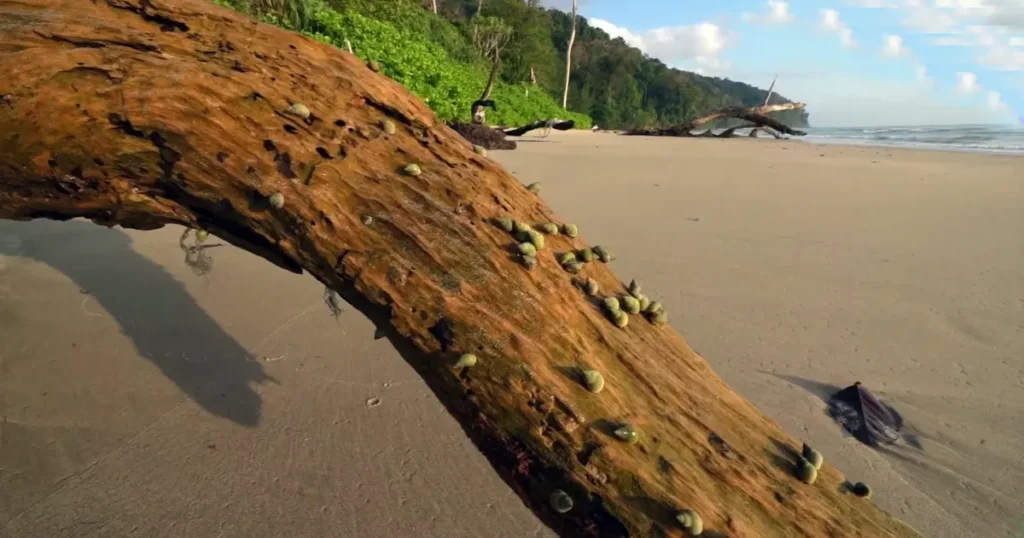Spread over 426.23 km2, Campbell Bay National Park is located in the Nicobar District of Andaman and Nicobar Islands, India, which is in the north-central part of the Great Nicobar Islands. The region’s coastal and mangrove environment harbours much native flora and fauna. This island geographically lies near the northern entrance of the Malacca Strait; it is a strategic point between the Bay of Bengal and the South China Sea.
The park’s geographical coordinates are 7°1’5.74″ N, 93°54’11.99″ E. Its proximity to Southeast Asia, including Sumatra and Thailand, connects it to the larger Indo-Malayan ecozone, contributing to its diverse flora and fauna.
The island is the habitat of the Nicobar Megapode, a rare bird that builds large dune nests to raise its eggs. Another important park species is the giant rubber crab, a unique creature found on the islands.
Distances to Campbell Bay National Park from major cities:
- Port Blair: 513 km
- Chennai: 1,614 km
- Visakhapatnam: 1,636 km

Campbell Bay National Park: A Sanctuary for Wildlife, Tribes, and Visitors
The notification of Campbell Bay National Park took place on the 18th of March in the year 1992. Furthermore, this area serves as the principal zone of the Great Nicobar Biosphere Reserve with the adjoining Protected Forest serving as the zones of transition. The Great Nicobar Biosphere Reserve was notified on January 13, 1989, vide notification No. J-22010/14/89-CSC. It was also notified as a World Heritage Site by UNESCO in 2013.
The Galathea National Park which is relatively smaller is also within the Biosphere Reserve area where it is 12 kilometers apart from the Campbell Bay National Park to the southern end, through a forest buffer zone.
On 12 March 2021, the Ministry of Environment, Forest and Climate Change (MoEFCC) issued a notification No. S.O. 1193(E) declares the area of 0 to 1 km around Campbell Bay National Park as an eco-sensitive zone covering a total area of 65.81 sq. km.
Due to the tsunami of 2004, Kondul Tribal village which was severely affected was relocated to Afra Bay in the North-Western section of Campbell Bay National Park within the Eco-sensitive Zone.
The Shompen tribe, which had around 229 individuals as per the 2011 Census, is a Particularly Vulnerable Tribal Group (PVTG) inhabiting Great Nicobar Island. They are forest-dwelling tribes who depend exclusively on hunting and gathering. The Campbell Bay National Park and its Eco-Sensitive Zone have been declared Tribal Reserves in accordance with the Andaman and Nicobar (Protection of Aboriginal Tribes) Regulation of 1956
In a historic General election in 2024 for the first time, the 7 members of the Shompen tribe residing in the Andaman and Nicobar Islands were able to cast their vote and also took selfies at polling station 411 known as ‘Shompen Hut.’
Visitors can reach Campbell Bay National Park by taking a ferry from Port Blair, which takes around 50-60 hours. Daily flights are available between Port Blair and Kolkata or Chennai, with a flight time of about 2 hours.
Accommodation: The APWD Guest House in Campbell Bay as well as hotels, and rest houses are available on the outskirts of Campbell Bay National Park, but prior booking is required, and reservations can be made online through the official Andaman tourism website.
The best time to visit Campbell Bay National Park is from December to March. Foreign nationals are required to obtain a Restricted Area Permit (RAP) to visit the Andaman & Nicobar Islands.
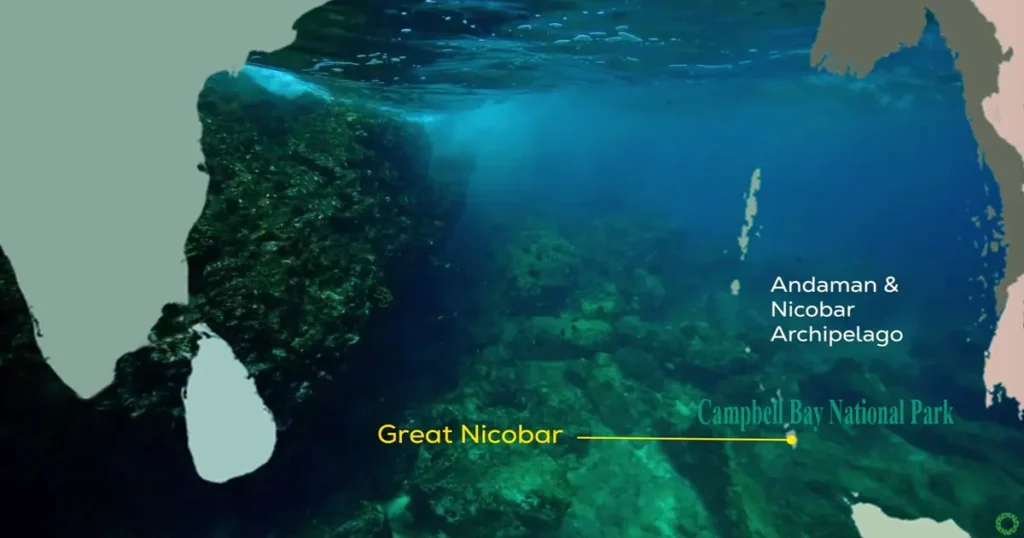
Biodiversity Highlights of Campbell Bay National Park
Many different species from the Indo-Chinese and Indo-Malayan regions are found at Campbell National Park. There are 648 plant species in all, belonging to 422 genera and 142 families. Of these, 48 are endemic, while 85 are rare or endangered. There are 77 pteridophytes and 4 gymnosperm species; tree ferns predominate on the slopes of interior forests.
The park is home to 330 wildlife species, including 28 mammals (3 marine animals), and 97 birds.
- 23 reptiles.
- 10 amphibians.
- 76 aquatic hemipterans.
- 52 butterflies.
- 24 odonates.
- 20 spiders.
Campbell Bay National Park is Famous For
Campbell Bay National Park is well-known for its diverse wildlife, including the Nicobar Crab-eating Macaque, Nicobar wild pig, Dugong, Nicobar Tree Shrew, Spiny Shrew, Nicobar Flying Fox, Nicobar Pipistrelle, Estuarine Crocodile and Nicobar Megapode, a rare bird that makes large dune nests to incubates its eggs. The beaches adjoining the protected area of the park are important nesting grounds for the Giant Leather Back Turtle, Green Sea Turtles, and Olive Ridley Turtle.
Campbell Bay National Park has one of the best-maintained tropical rain forests in the world, with a high degree of endemism due to its remote geographic location and isolation. Apart from its biodiversity, the park is important for
- Ecological: Contributes to maintaining the ecosystem.
- Flora and Fauna: The plants and animals present in the park are peculiar and are not found in any other geography.
- Geomorphologic: It possesses different and unique landforms and physical features of the earth.
- Recreational: Activities like hiking and tourism are available in the park.
- Research/Education: Significance of its place in research about nature and in educating the population in the field of nature and its protection.

Campbell Bay National Park Map
The map of Campbell National Park is marked by the MoEFCC issued Notification S.O. 1193(E) on 12th March 2021, under the Environment (Protection) Act, 1986. With its 426.23 square kilometers, the park provides an essential home for a wide variety of plants and animals.
An Eco-Sensitive Zone (ESZ) spanning 0 to 1 km outside the park’s boundaries and covering 65.81 square kilometers has been designated. The purpose of this ESZ is to safeguard the biodiversity both inside and outside of Campbell Bay National Park and to prevent development from compromising the park’s natural integrity.
Boundary Description of Campbell Bay National Park
The boundary description of the Campbell Bay National Park’s Eco-sensitive Zone (ESZ) based on the cardinal directions:
1. North:
The northern boundary of the ESZ follows the northern boundary of Campbell Bay National Park, starting from point 14 (7°10’29.435” N, 93°40’35.571” E) and moving to point 1 (7°12’48.477” N, 93°51’8.036” E) on the northeastern boundary of the park.
2. East:
From point 1 (7°12’48.477” N, 93°51’8.036” E), the boundary moves east to point A1, then south to point A4, passing through points A2 and A3, while maintaining a one-kilometer distance from the seaward boundary.
3. South:
The southern boundary of the Campbell Bay National Park is part of the Great Nicobar Biosphere Reserve and is separated from Galathea National Park by a 12-km forest buffer zone. From point A4 (7°0’19.620” N, 93°50’57.591” E), the boundary moves west through points A5, A6, A7, and A8, maintaining a uniform distance of one kilometer from the park’s boundary.
4. West:
From point A8 (6°57’56.254” N, 93°44’35.214” E), the boundary moves north to point A9, then to point A10, following the western boundary of the park. It continues north through points A11 to A24, maintaining a distance of 200 meters to one kilometer from the park’s boundary, and ends at point 14 (7°10’29.435″ N, 93°40’35.571” E).
Geography of Campbell Bay National Park
The geography of Campbell Bay National Park is such that its vegetation and biodiversity, together with the insular nature of the region, allow a unique tropical humid climate due to proximity to the equator, the physical isolation of the islands, and the impact of both South-West and North-East monsoons; hence, the national park has dense and varied vegetation cover.
Owing to its remote location, the tropical rainforest in Campbell Bay National Park has remained relatively undisturbed and allows for a high level of endemism. Elements from both Indo-Chinese and Indo-Malayan regions are included within the National Park.
1. River: There are five perennial rivers in Campbell Bay National Park, rising from Mt. Thullier, which lies at a height of 2,106 feet (642 meters) and is the highest peak in that area. This area is of primary importance concerning freshwater supply for the inhabitants throughout the Great Nicobar Islands. Galathea, the longest and widest among these rivers, finds its way southward into Galathea Bay. The Jubilee River flows to the north, while the Alexandra, Dagmar, and Amrit Kaur rivers flow westward.
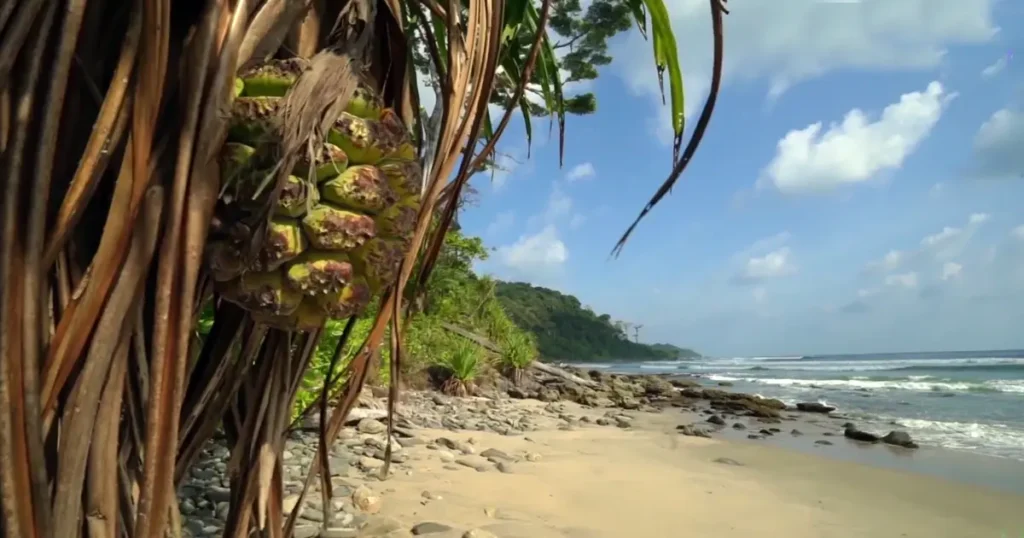
Climate of Galathea National Park
The climate of Campbell Bay National Park is tropical humid climate due to its closer to the equator, its insular nature, and the physical isolation of the islands. The impact of monsoons in the North-East and South-West helps develop the growth of dense and diverse shrubbery. The people and animals here experience only a rainy season and summer. The average rainfall during the rainy season is 3000 to 3800 mm each year.
1. Forests of Campbell Bay National Park:
Campbell Bay National Park is a rich park with a rich variety of plant life. The park has a variety of forests including mangrove forests, coastal forests, Low-level Evergreen Forests, and tropical evergreen forests. On the hill slopes, there are many tree ferns, which form a large part of the vegetation.
Some of the rare plants found in the park are tree ferns, special flowers, and climbing trees. The park also has 14 species of mangrove trees, such as red mangroves and mangrove apples.
Mangroves are very important as they protect the environment, particularly the coast.
Moreover, the park boasts climbers and lianas- tall vines. Most of the species of the park are epiphytes, i.e. plants growing off other plants. Most common among the climbers are derris and sarcolobus, and ferns and orchids are seen growing on tree branches.
Besides being lovely, some of the plants at the park are commercially important as well. Several wild species such as nipa palm and wild vanilla are found here, which are very useful. So many plants make the park a delight for nature lovers.
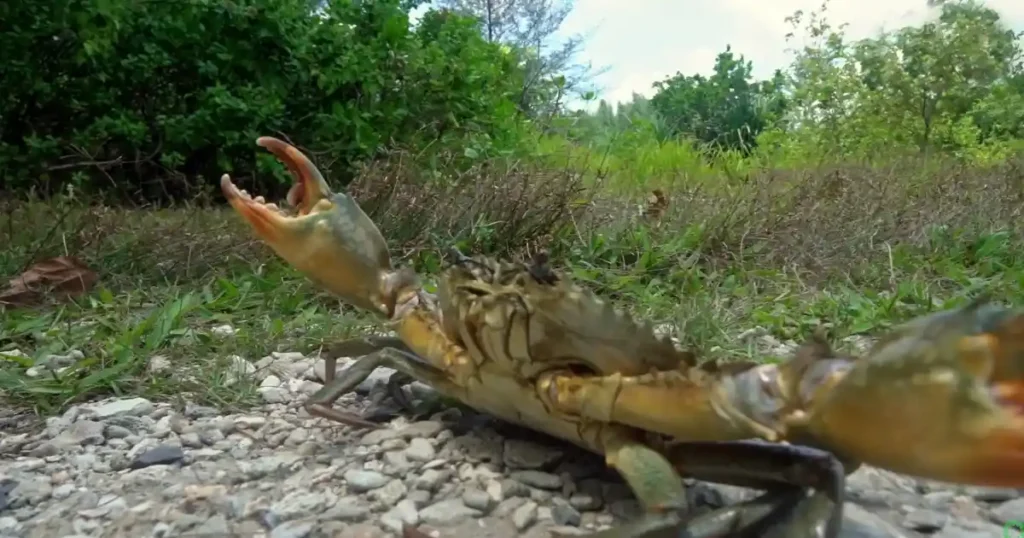
2. Wildlife of Campbell Bay National Park
- Mammals: Mammals: Campbell Bay National Park has recorded 28 mammalian species, some of which live in the ocean. One of the special animals of the park is the Nicobar Crab-Eating Macaque, a kind of monkey endemic to this area. The park is inhabited by the endemic subspecies of the Nicobar Crab-Eating Macaque a monkey, the Nicobar Wild Pig, the Nicobar Tree Shrew, the Nicobar Flying Fox (a type of bat), and the Spiny Shrew. There are some other mammalian species such as Rodents, and the leaf-nosed bats of Nicobar Island. Dugong known as the sea cow is one of the few marine mammals also seen in this park.
- Reptiles: The park has 23 types of reptiles. There is an Andaman Water Monitor, which is a large kind of social lizard that enjoys water. There is also Tiwari’s Garden Lizard and the famous Estuarine Crocodile is known for living in both fresh and saltwater.
- Birds: There are 97 bird species, many being endemic or exclusively native to the Nicobar Islands, such as the Nicobar Tiger Bittern, Nicobar Cuckoo Dove, Nicobar Emerald Dove, and the Nicobar Paradise Flycatcher. Other species include the Nicobar Megapode, a bird that creates huge nests built like a mound, and the Nicobar Hill Myna, noted for its sound mimicry. Other birds of interest found here are the Nicobar Pigeon and the Nicobar Red-Cheeked Parakeet.
- Sea Turtles: The beaches of Campbell Bay are important nesting grounds for three types of sea turtles such as the Giant Leatherback Turtle, the Olive Ridley Turtle, and the Green Sea Turtle. These turtles come to lay their eggs on the sandy shores.
- Arthropods: Many insects are also present in the park, such as 52 varieties of butterflies, 24 dragonflies, 20 varieties of spiders, and 76 types of water beetles. The butterflies found here have striking colors adding beauty to the park.

The Best Time to visit the Park
December to February is the best time to visit Campbell Bay National Park. With the weather being pleasant and comfortable during this time, it is good for park exploration and perfect for outdoor activities. Campbell Bay National Park has plenty of flora and fauna that people get to see during the trip including; Megapode, crab-eating macaque, Nicobar pigeon, giant robber crab, olive ridley turtle, leatherback turtle, wild boar, deer, civet, Nicobar tree shrew, and many more. The park offers the following recreational activities:
• Trekking.
• Sunbathing
• Spotting wildlife.
• Experience bird watching.
• Taking a nature walk.
• Nature offers a relaxing environment.
• Enjoying views from the watchtower.
How to Get There
By Air: To get to Campbell Bay, take the government helicopter service from Port Blair.
By Sea: Campbell Bay can be reached by using the inter-island boat service that leaves Port Blair. The travel experience is so beautiful that it becomes an adventure in itself, taking nearly a week to complete. In the alternative, one can board the MV Campbell Bay, which is a government ship and travels by sea from Port Blair to Campbell Bay in nearly 24 hours. It travels once every week.
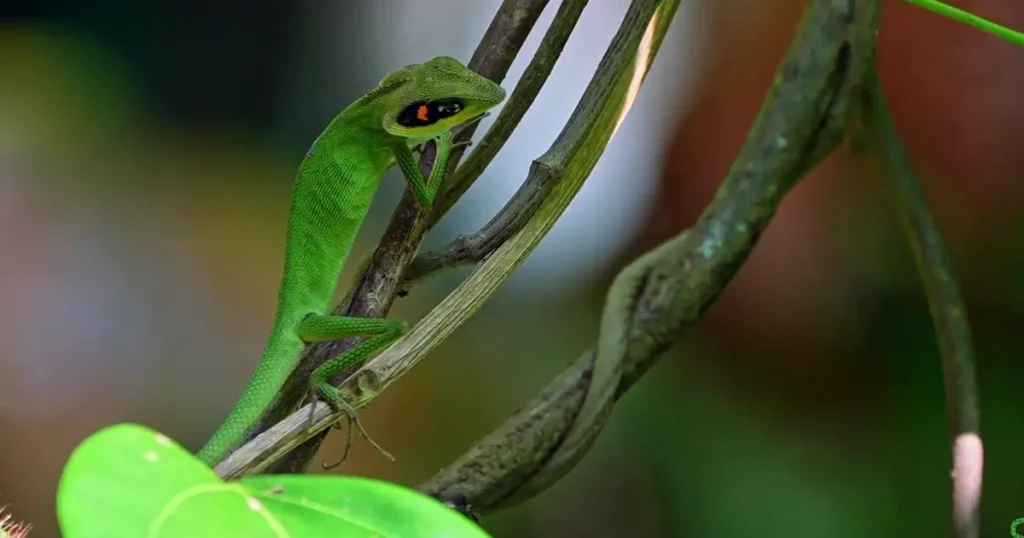
Where to Stay
The APWD Guest House in Campbell Bay can be booked online at the official Andaman tourism website. There are also some resorts where you can stay in either a lodge or a wildlife resort. Foreign nationals need a Restricted Area Permit to visit Andaman and Nicobar Islands, so applying for it well in advance is suggested to avoid any delays.
Conclusion
Campbell Bay National Park is one of the prominent UNESCO World Heritage Sites and a rare plant and animal sanctuary well located within the Great Nicobar Biosphere Reserve on Great Nicobar Island. Its rainforests, mangroves, and five perennial rivers support a full range of species many of which are found nowhere else on this earth. This includes endangered animals such as the Nicobar crab-eating macaque an endangered flightless bird called the Nicobar megapode, which lays eggs in large mounds, and the large leatherback turtle nesting on adjacent beaches.
The park area has been stretched into an Eco-sensitive Zone to save the Aboriginal tribe and preserve its ecological, environmental, and biodiversity value, which prohibits industries and their operation within the area.
The ongoing process of conservation and ecotourism at Campbell Bay National Park reminds one how very often human activity has to be balanced with the protection of the environment.
FAQ
Q: What is Campbell Bay National Park famous for ?
A: Campbell Bay National Park is famous for numerous species of endemic and threatened fauna including the Nicobar Crab-eating Macaque, Nicobar Wild Pig, Estuarine Crocodile, Garden Lizard, Nicobar Megapode, and the nesting activity of Giant Leatherback Turtles, Olive Ridley Turtles, and Green Sea Turtles.
Q: Can I visit Campbell Bay?
A: While the Campbell Bay National Park can be visited freely by Indian visitors, foreign nationals need to obtain a Restricted Area Permit to enter the Andaman and Nicobar Islands.
Q: The relevance of Campbell Bay National Park in UPSC examinations.
Campbell Bay National Park is located in the Nicobar District of the Andaman & Nicobar Islands. It is a part of the Great Nicobar Biosphere Reserve status granted on January 13, 1989, and declared a National Park in 1992 covering 426.23 sq. km. It was recognized as a World Heritage Site in 2013 by UNESCO.
You May Also Like

